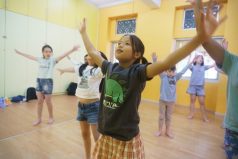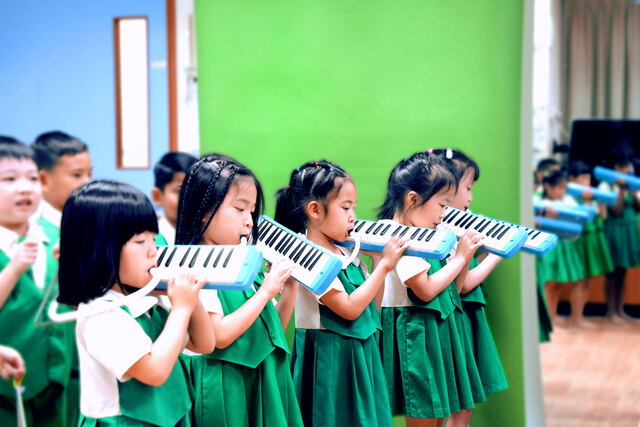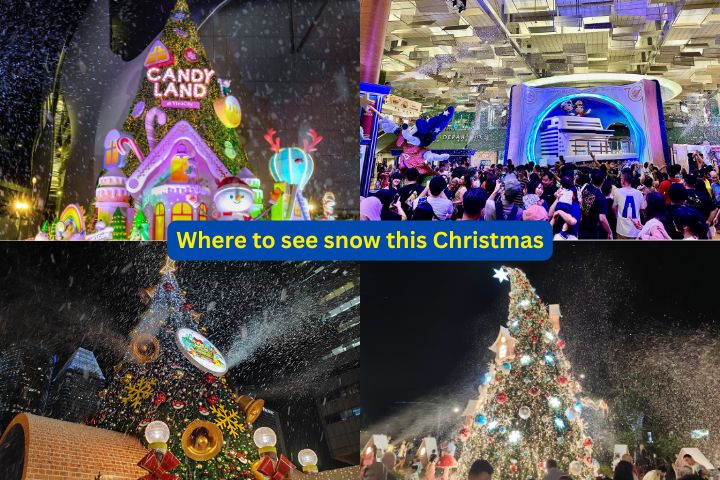EXPLORE THE LITTLE ISLAND WITH A BIG HISTORY ON THE NEW SENTOSA HERITAGE TRAIL
To the south of mainland Singapore, the island of Sentosa sits proudly as a multifaceted leisure destination, and a popular respite from the hustle and bustle of the city. But the sandy beaches, hotels, theme parks and attractions belie a long and rich heritage that is waiting to be explored.
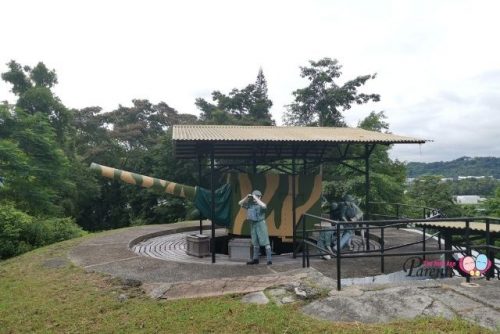
Featuring 30 heritage sites – including the recently gazetted National Monument Fort Siloso – and supplemented by 10 heritage trail markers, the new Sentosa Heritage Trail, developed by the National Heritage Board (NHB) in partnership with Sentosa Development Corporation (SDC), traces the transformation of the island from a military complex to a leisure destination, uncovers stories of the communities who once lived there, and sheds light on the story of modern Sentosa’s reinvention. These trail markers are augmented by another 20 existing interpretive signs to enrich guests’ knowledge of Sentosa’s history.
Existing in records dating back to the 1600s as Pulau Blakang Mati – which translates to “Death from the Back Island” in Malay – the island was home to various coastal communities such as the Orang Laut and other regional groups, and was also coveted by colonial powers due to its strategic location on the much-used straits of Singapore. During World War II (WWII), the construction of Fort Siloso, Fort Serapong and other military facilities marked the island as an important base for military activity, and some remnants of its wartime past remain hidden in plain sight.
Lesser-known Stories of Sentosa’s Kampong Communities
The Sentosa Heritage Trail also unearths the history of the early settlers on the island comprising diverse communities across different time periods. Early records dating as far back as the 17th century confirm the presence of Orang Laut communities on the island, who made their living by fishing and selling commodities to passing vessels between mainland Singapore and Blakang Mati. Even after Blakang Mati was turned into a British military outpost, civilian communities still lived on the island, with many continuing to do so even after WWII. These civilian communities made a living by fishing, operating small shops and providing a ferry service between the island and mainland Singapore. For a visual record of Pulau Blakang Mati’s early communities, please refer below.
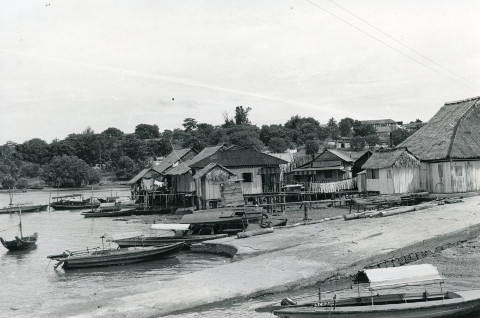 Former kampongs located next to the jetty on Blakang Mati, 1957
Former kampongs located next to the jetty on Blakang Mati, 1957
Courtesy of Sentosa Development Corporation
Discover the Island’s Rich Military History
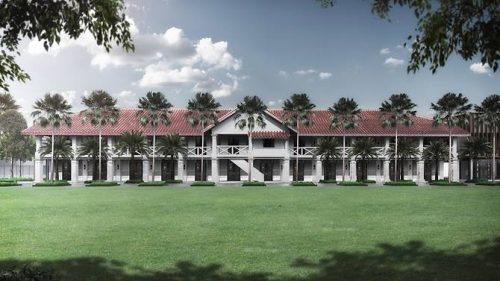 Photo: Far East Hospitality
Photo: Far East Hospitality
The Sentosa Heritage Trail delves into the island’s military history, which began when Singapore became a British colony in the 1800s. Blakang Mati was recognised for its strategic potential in Britain’s defense strategy for Singapore, which was centred on defending Keppel Harbour and the shipping straits around the island. The completion of Fort Siloso and other forts and batteries on the island also meant that barracks and quarters to house military personnel had to be built.
Many landmarks from Sentosa’s time as a military bastion still exist today as buildings which have been seamlessly integrated into Sentosa’s modern landscape. Former barracks have been repurposed into hotels and restaurants, while forts and other military structures have been restored and utilised for education and entertainment, giving heritage sites new leases of life to meet the needs of modern visitors. For a visual record of sites that showcase Sentosa’s military heritage, please refer below:
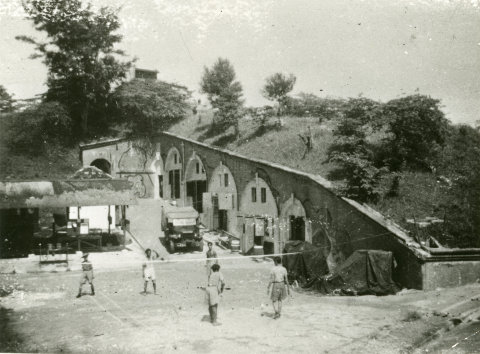 Soldiers playing badminton at Fort Siloso, c. 1940-50s
Soldiers playing badminton at Fort Siloso, c. 1940-50s
Courtesy of Sentosa Development Corporation
 Fort Siloso
Fort Siloso
From Blakang Mati to Sentosa
This year, Sentosa is commemorating the 50th anniversary since the island was established as a leisure destination in 1972. The Sentosa Heritage Trail and its companion guide cover the island’s early history (including its military heritage) and feature some of its earliest attractions such as the Singapore Cable Car and the site of the former Musical Fountain and Fountain Gardens. The companion guide also includes stories of the island’s early days as a leisure destination. In addition, heritage trail markers are placed along remnants of the old monorail track and within Resorts World Sentosa to highlight the locations of these former landmarks. For a visual record of Sentosa’s early attractions, please refer below.
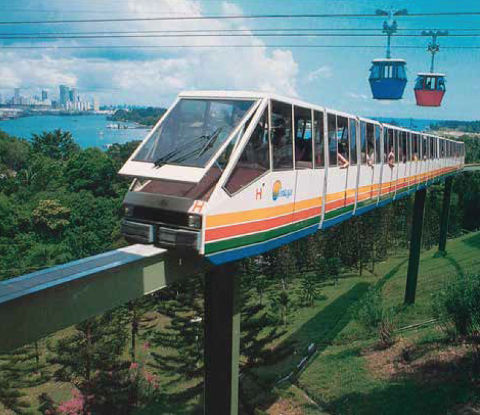 A monorail trail heading to the west of Sentosa, mid-1980s National Museum of Singapore Collection, Courtesy of National Heritage Board
A monorail trail heading to the west of Sentosa, mid-1980s National Museum of Singapore Collection, Courtesy of National Heritage Board
Explore Sentosa’s Heritage at Your Leisure
Mr Alvin Tan, Deputy Chief Executive (Policy & Community), NHB, said: “Through this trail, we hope to bring Singaporeans and tourists alike on an island journey through time to discover heritage sites and stories – both familiar and unfamiliar. In doing so, we hope that they will learn more about Sentosa’s island, military and leisure heritage, and realize that there is always something new and exciting to discover in Sentosa.”
Mr Michael Ma, Assistant Chief Executive, SDC, said: “The Sentosa Heritage Trail is an opportunity for our guests to unearth Sentosa’s storied past. With many of our historic landmarks still existing today, the trail also underscores SDC’s commitment to preserving Sentosa’s rich history for future generations. The trail complements our recently-launched range of heritage- and sustainability-themed tours, SentoSights, and we invite Singaporeans and our guests to rediscover Sentosa in our 50th year as a multifaceted leisure destination.”
To explore the fascinating history of Sentosa, trail-goers can embark on three thematic, bite-sized routes according to their interests and in their own time. These routes are:
● Kampongs and Barracks (2 hours on foot and with public transport), 3km
This route explores the lives and livelihoods of the people of Blakang Mati, as well as their living spaces that included kampongs, barracks, and luxurious bungalows
● Forts (2 hours on foot), 4km
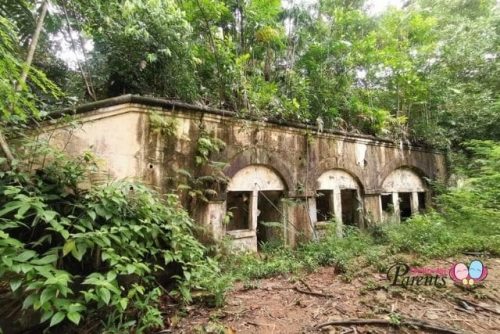 Fort Serapong
Fort Serapong
This route explores the extensive fortifications on Sentosa, including Fort Siloso, Imbiah Battery and Fort Serapong, and how they featured in the defence of colonial Singapore.
● Memories of Sentosa (1 hour on foot), 2.5km
This route revisits some of the locations that are iconic of Sentosa’s reinvention as a leisure destination in the 1970s, and the memories associated with these landmarks.
The Sentosa Heritage Trail’s companion guide and map (the map is available in four languages from early April) can be downloaded from NHB’s heritage portal and Sentosa.com.sg. Printed copies of the guide will also be available for a limited period at NHB headquarters at Stamford Court.
SENTOSA HERITAGE TRAIL – THREE THEMATIC TRAIL ROUTES
The Sentosa Heritage Trail features three thematic trail routes of varying distances, which the public can embark on in their own time.
1. Kampongs and Barracks (2 hours on foot and with public transport, 3km)
From the Orang Laut and kampong settlers to British Army personnel, a diverse range of people and communities have called Pulau Blakang Mati home. This trail explores the lives and livelihoods of the people of Blakang Mati, as well as their living spaces that included kampongs, barracks and luxurious bungalows.
- Sentosa Gateway boardwalk – People of the Straits trail marker (Recommended starting point)
- Former recreation ground and barracks
- Barracks at the former parade ground
- Former Royal Engineers’ Yard
- Former Officers’ Mess and Quarters
- Former military hospital
2. Forts (2 hours on foot, 4km)
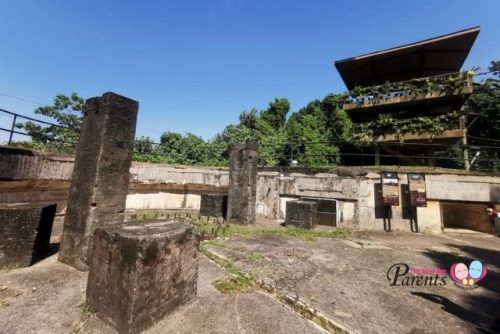 Imbiah Battery
Imbiah Battery
Pulau Blakang Mati had been identified as a potential defence outpost since at least the 17th century. However, it was only in the late 1800s that the island was militarised, with artillery batteries, forts, barracks and other infrastructure constructed by the British after they took over Pulau Blakang Mati. This trail explores the extensive fortifications on Sentosa, including Fort Siloso, Imbiah Battery and Fort Serapong, and how they featured in the defence of colonial Singapore.
- Siloso Point Station (Recommended starting point)
- Fort Siloso Skywalk
- Fort Siloso
- Siloso Pier
- Imbiah Battery
- Fort Serapong (Optional)
3. Memories of Sentosa (1 hour on foot, 2.5km)
Since the 1970s and following its reinvention as a leisure destination, Sentosa has continually refreshed its attractions to adjust to shifting visitor preferences over the decades. A number of former attractions including the Musical Fountain and the monorail helped define Sentosa in the 1980s and 1990s, and still feature significantly in the social memories of Singaporeans. This trail revisits some of these locations and the memories associated with them.
- Siloso Point Station (Recommended starting point)
- Siloso Beach
- Former Sentosa Monorail
- Singapore Cable Car
- Former military hospital
- The Musical Fountain, the Ferry Terminal and the Fountain Gardens
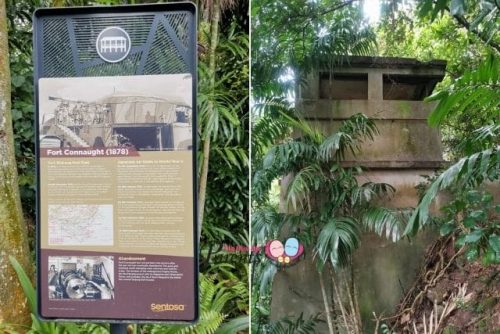 Fort Connaught
Fort Connaught
SENTOSA HERITAGE TRAIL SITES AND MARKERS
1. Fort Siloso*
2. Siloso Pier*
3. Imbiah Battery
4. Fort Serapong
5. Fort Connaught
6. Berhala Reping
7. Soldiers Blocks (Blocks 16, 17, 26 and 28)
8. Married Soldiers Quarters (Blocks 32, 41-44)
9. Former Officers’ Mess and Quarters (Blocks 48-51)*
10. Former Recreation Ground and Barracks (Blocks 9-11)*
11. Asiatic Soldiers Block (Block 59)
12. Australia House (Block 69)
13. Former Kashima Jinja
14. Former Military Hospital*
15. People of the straits and former kampongs in Sentosa: Kampong Ayer Bandera, Kampong Serapong, Kampong Blakang Mati, and other unnamed kampongs*
16. Former Blakang Mati Integrated Primary School
17. Former Sarong Island
18. Sentosa Golf Club
19. Sentosa Satellite Earth Station
20. Singapore Cable Car*
21. Former Coralarium
22. Former Maritime Museum
23. Surrender Chambers
24. Former Sentosa Monorail*
25. Former Musical Fountain*
26. Former Fountain Gardens*
27. Former Ferry Terminal*
28. Former Underwater World
29. Former Sentosa Merlion
30. Siloso Beach
* Heritage sites with markers
Total: 30 sites
Heritage sites featured inside trail markers are in BOLD (note that multiple sites can be featured on the same marker as some of these sites are located in close proximity to one another).
➡️ Related Read: List of Heritage Trails Developed by the National Heritage Board
* * * * *
Like what you see here? Get parenting tips and stories straight to your inbox! Join our mailing list here.
Want to be heard 👂 and seen 👀 by over 100,000 parents in Singapore? We can help! Leave your contact here and we’ll be in touch.










